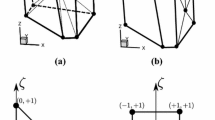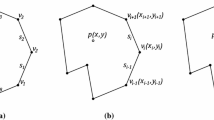Abstract
In this paper, a h-adaptive methodology based on the polytopal meshes is proposed for capturing high stress gradients at the materials corners and the stress singularities at the vicinity of a crack tip. The adaptive refinement is based on the error indicator directly computed from the displacement solutions of the scaled boundary finite element method. Based on the error indicator, a polygon of n-sides which has an error exceeding a specified tolerance is subdivided recursively into \((n+1)\) child polygons. The salient features of the proposed framework are: (a) circumvents a need for post-processing techniques for error estimation; (b) elements with hanging nodes are treated as polygons without a need for special treatment and (c) stress gradients and stress singularities are accurately captured due to the semi-analytical formulation. The robustness and the convergence properties of the proposed framework is demonstrated with three benchmark examples.













Similar content being viewed by others
References
Strouboulis, T., Babuška, I., Copps, K.: The desing and analysis of the generalized finite element method. Comput. Methods Appl. Mech. Eng. 181, 43 (2000)
Moës, N., Dolbow, J., Belytschko, T.: A finite element method for crack growth without remeshing. Int. J. Numer. Methods Eng. 46(1), 131 (1999). https://doi.org/10.1002/(SICI)1097-0207(19990910)46:1<131::AID-NME726>3.0.CO;2-J
Melenk, J.M., Babuška, I.: The partition of unity finite element method: basic theory and applications. Comput. Methods Appl. Mech. Eng. 139, 289 (1996)
Szabó, B., Mehta, A.: p-Convergence finite element approximations in fracture mechanics. Int. J. Numer. Methods Eng. 12, 551 (1978)
Šolín, P., Červený, J., Doležel, I.: Arbitrary-level hanging nodes and automatic adaptivity in the hp-FEM. Math. Comput. Simul. 77(1), 117 (2008)
Ainsworth, M., Senior, B.: Aspects of an adaptive hp-finite element method: adaptive strategy, conforming approximation and efficient solvers. Comput. Methods Appl. Mech. Eng. 150(1–4), 65 (1997)
Demkowicz, L.: Computing with Hp-Adaptive Finite Elements One and Two Dimensional Elliptic and Maxwell Problems. Chapman & Hall/CRC, Boca Raton (2007)
Cao, W., Huang, W., Russell, R.: An r-adaptive finite element method based upon moving mesh PDEs. J. Comput. Phys. 149, 221 (1999)
Pierre, B., Koko, J., Touzani, R.: Mesh r-adaptation for unilateral contact problems. Int. J. Appl. Math. Comput. Sci. 12, 9 (2002)
Burgarelli, D., Kischinhevsky, M., Biezuner, R.J.: An r-adaptive finite element method based upon moving mesh PDEs. J. Comput. Appl. Math. 196(1), 115 (2006)
Cheng, G., Li, H.: Higher-order XFEM for curved strong and weak discontinuities. Comput. Struct. 59(5), 823 (1996)
Douglass, R.W.: Laplace–Beltrami enhancement for unstructured two-dimensional meshes having dendritic elements and boundary node movement. J. Comput. Appl. Math. 236(18), 4952 (2012)
Feischl, M., Page, M., Praetorius, D.: Convergence and quasi-optimality of adaptive FEM with inhomogeneous Dirichlet data. J. Comput. Appl. Math. 255(100), 481 (2014)
Areias, P., Msekh, M., Rabczuk, T.: A three-dimensional large deformation meshfree method for arbitrary evolving cracks. Eng. Fract. Mech. 158, 116 (2016). https://doi.org/10.1016/j.engfracmech.2015.10.042
Areias, P., Reinoso, J., Camanho, P., de Sa, J.C., Rabczuk, T.: Effective 2D and 3D crack propagation with local mesh refinement and the screened Poisson equation. Eng. Fract. Mech. 189, 339 (2018). https://doi.org/10.1016/j.engfracmech.2017.11.017
Frey, P.J., Marechal, L.: Hanging nodes and XFEM. In: Proceedings of the Seventh International Meshing Roundtable, Dearborn, MI (1998)
Morvan, Y., Farin, D.: Depth-image compression based on an RD optimized quadtree decomposition for the transmission of multiview images. In: IEEE International Conference on Image Processing, ICIP 2007, 5, p. V105 (2007)
Popinet, S.: A quadtree-adaptive spectral wave model. Ocean Dyn. 61(9), 1261 (2011)
Yiu, K., Greaves, D., Cruz, S., Saalehi, A., Borthwick, A.: An adaptive scaled boundary finite element method by subdividing subdomains for elastodynamic problems. Comput. Fluids 25(8), 759 (1996)
Gupta, A.K.: Quadtree-based triangular mesh generation for finite element analysis of heterogeneous spatial data. Int. J. Numer. Methods Eng. 12, 35 (1978)
Rachowicz, W., Oden, J.T., Demkowicz, L.: Toward a universal hp adaptive finite element strategy part 3. Design of hp meshes. Comput. Methods Appl. Mech. Eng. 77, 181 (1989)
Lo, S., Wan, K., Sze, K.: Adaptive refinement analysis using hybrid-stress transition elements. Comput. Struct. 84, 2212 (2006)
Sukumar, N.: Conforming polygonal finite elements. Int. J. Numer. Methods Eng. 61(12), 2159 (2004)
Ooi, E., Man, H., Natarajan, S., Song, C.: Crack ppropagation modelling in functionally graded materials using scaled boundary polygons. Eng. Fract. Mech. 144, 101 (2015)
Tabarraei, A., Sukumar, N.: Extended finite element method on polygonal and quadtree meshes. Comput. Methods Appl. Mech. Eng. 197, 425 (2008)
Oden, J., Demkowicz, L., Rachowicz, W., Westermann, T.: Toward a universal hp adaptive finite element strategy, part 2. A posteriori error estimation. Comput. Methods Appl. Mech. Eng. 77, 113 (1989)
Nguyen-Thanh, N., Zhou, K., Zhuang, X., Areias, P., Nguyen-Xuan, H., Bazilevs, Y., Rabczuk, T.: Isogeometric analysis of large-deformation thin shells using RHT-splines for multiple-patch coupling. Comput. Methods Appl. Mech. Eng. 316, 1157 (2017). https://doi.org/10.1016/j.cma.2016.12.002
Anitescu, C., Hossain, M.N., Rabczuk, T.: Recovery-based error estimation and adaptivity using high-order splines over hierarchical T-meshes. Comput. Methods Appl. Mech. Eng. 328, 638 (2018). https://doi.org/10.1016/j.cma.2017.08.032
Wachspress, E.L.: A Rational Finite Element Basis, vol. 114. Academic Press, New York (1975)
Moorthy, S., Ghosh, S.: Adaptivity and convergence in the Voronoi cell finite element model for analyzing heterogeneous materials. Comput. Methods Appl. Mech. Eng. 185(1), 37 (2000). https://doi.org/10.1016/S0045-7825(99)00349-7
Sze, K., Sheng, N.: Polygonal finite element method for nonlinear constitutive modeling of polycrystalline ferroelectrics. Finite Elem. Anal. Des. 42(2), 107 (2005). https://doi.org/10.1016/j.finel.2005.04.004
Nguyen-Xuan, H., Nguyen-Hoang, S., Rabczuk, T., Hackl, K.: A polytree-based adaptive approach to limit analysis of cracked structures. Comput. Methods Appl. Mech. Eng. 313, 1006 (2017). https://doi.org/10.1016/j.cma.2016.09.016
Chau, K.N., Chau, K.N., Ngo, T., Hackl, K., Nguyen-Xuan, H.: A polytree-based adaptive polygonal finite element method for multi-material topology optimization. Comput. Methods Appl. Mech. Eng. 332, 712 (2018). https://doi.org/10.1016/j.cma.2017.07.035
Nguyen, K.C., Tran, P., Nguyen, H.X.: Multi-material topology optimization for additive manufacturing using polytree-based adaptive polygonal finite elements. Autom. Constr. 99, 79 (2019). https://doi.org/10.1016/j.autcon.2018.12.005
Vu-Huu, T., Phung-Van, P., Nguyen-Xuan, H., Wahab, M.A.: A polytree-based adaptive polygonal finite element method for topology optimization of fluid-submerged breakwater interaction. Comput. Math. Appl. 76(5), 1198 (2018). https://doi.org/10.1016/j.camwa.2018.06.008
Tabarraei, A., Sukumar, N.: Adaptive computations on conforming quadtree meshes. Finite Elem. Anal. Des. 41(7–8), 686 (2005)
Talischi, C., Paulino, G.H., Pereira, A., Menezes, I.F.M.: PolyTop: a Matlab implementation of a general topology optimization framework using unstructured polygonal finite element meshes. Struct. Multidiscip. Optim. 45(3), 329 (2012)
Song, C.: The Scaled Boundary Finite Element Method: Introduction to Theory and Implementation. Wiley, Hoboken (2018). https://doi.org/10.1007/978-3-642-23099-8
Deeks, A.J., Wolf, J.P.: Stress recovery and error estimation for the scaled boundary finite-element method. Int. J. Numer. Methods Eng. 54(4), 557 (2002). https://doi.org/10.1002/nme.439
Song, C., Wolf, J.P.: The scaled boundary finite-element method-alias consistent infinitesimal finite-element cell method for elastodynamics. Comput. Methods Appl. Mech. Eng. 147(3–4), 329 (1997). https://doi.org/10.1016/S0045-7825(97)00021-2
Deeks, A.J., Wolf, J.P.: A virtual work derivation of the scaled boundary finite-element method for elastostatics. Comput. Mech. 28(6), 489 (2002). https://doi.org/10.1007/s00466-002-0314-2
Ooi, E.T., Yang, Z.J.: A hybrid finite element-scaled boundary finite element method for crack propagation modelling. Comput. Methods Appl. Mech. Eng. 199(17–20), 1178 (2010)
Song, C.: A matrix function solution for the scaled boundary finite element equation in statics. Int. J. Numer. Methods Eng. 61(8), 1332 (2004). https://doi.org/10.1002/nme.1117
Zienkiewicz, O., Zhu, J., Gong, N.: Effective and practical hp-version adaptive analysis procedures for the finite element method. Int. J. Numer. Methods Eng. 28, 879 (1989)
Talischi, C., Paulino, G.H., Pereira, A., Menezes, I.F.M.: PolyMesher: a general-purpose mesh generator for polygonal elements written in Matlab. Struct. Multidiscip. Optim. 45, 309 (2012)
Liu, Y.C., Elmaraghy, H.A.: Assessment of discretized errors and adaptive refinement with the quadrilateral finite elements. Int. J. Numer. Methods Eng. 33, 781 (1992)
Author information
Authors and Affiliations
Corresponding author
Additional information
Publisher's Note
Springer Nature remains neutral with regard to jurisdictional claims in published maps and institutional affiliations.
Rights and permissions
About this article
Cite this article
Aladurthi, L.N.P., Kamdi, K., Hung, NX. et al. An adaptive polytree approach to the scaled boundary boundary finite element method. Int J Adv Eng Sci Appl Math 12, 171–182 (2020). https://doi.org/10.1007/s12572-020-00280-8
Accepted:
Published:
Issue Date:
DOI: https://doi.org/10.1007/s12572-020-00280-8




